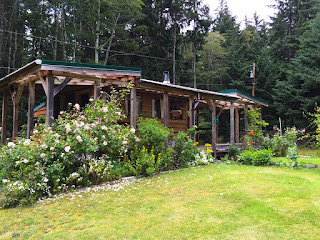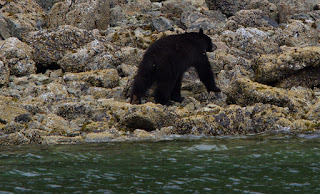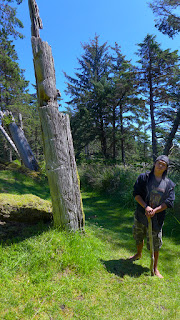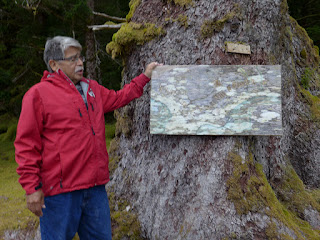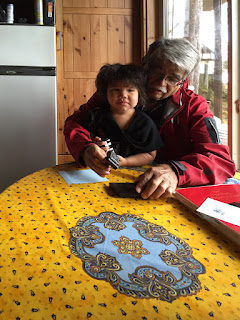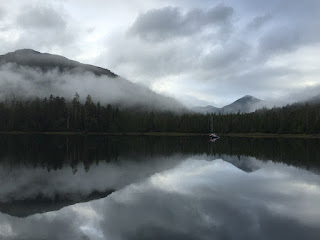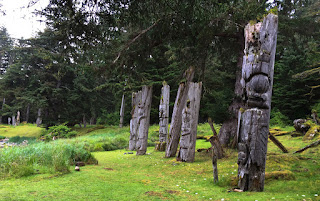June 11 – Crossing Cape Caution to
Northern British Columbia
We made our way efficiently to the
north end of Vancouver Island, then left on the 10
th from
Port McNeil through Goletas Channel where we checked out God's Pocket
as a potential anchorage. It is a small scuba resort which looks
quite inviting with its colorfully painted wood buildings.
 |
| God's Pocket Resort |
However it was a bit breezy in the small anchorage so we
decided to move on to Port Alexander, anchoring in completely calm
water, protected from the NW and surrounded by trees on three sides.
There were tons of huge, fresh logs stacked on the beach at the south
end. Accordingly, Waggoner's cautions this is not the place to be in a southerly!
Next day, the anchor was up at 0615, ready to
catch the ebb north to Cape Caution. We would be crossing the
southern part of Queen Charlotte Sound where the Pacific fetch is
long and can create steep waves over the shallow shelf we would be
sailing. We left the dock with one reef in the main, first motoring
west through Gordon Channel so we could then sail north all the way
past Cape Caution in the NW wind as forecast:
NW 5-15
kts increasing to NW 15-20 by noon, diminishing to 5-15 to evening.
SE 15-25 Sunday morning. The wind did not develop as forecast! It
fluctuated between 9-15 kts, only it was a southerly which, mixed with
the 2' westerly swell, made the sails bang from side to side. Even
so, in the light wind we
did sail 3 kts SOG all the way past
Cape Caution! Low stress, the way we like it, compared with how it could have been with
big wind and the resulting waves.
 |
| Two miles off the dreaded Cape Caution |
Our destination was Fury Cove,
tucked off the west side of Fitz Hugh Sound. By its description it
would be a perfect anchorage with a white shell beach at one end
where views of the Pacific beyond could be seen. Then, weighing prudence against beauty, we decided to first check out the more
secure Fry Pan and Big Fry Pan coves further east in River's Inlet,
for the southeasterly was by this time expected to reach 30 kts. Both
anchorages were securely surrounded by trees with nowhere to get off
the boat and boring! So we left for Fury Cove, mindful of an escape plan
to Secure Anchorage if needed, and found the beautiful cove as
described, plus nine other boats already anchored. A group of
cruisers from Gibson's Landing was heading towards shore for a
sunset dinner rendezvous. As for the big blow overnight, it
never developed!
 |
| Fury Cove anchorage |
Morning in Fury
Cove: drizzle and light wind....shore excursion cancelled! Several
other options: Dawson's Landing, an old-time general store with docks
and a few fishermen cabins in Darby Channel off River's Inlet, or
head out to Fitz Hugh Sound while a good sailing wind prevailed. We
decided to do both. With just the jib flying we were sailing
effortlessly in Fitz Hugh at 6 kts with 24 kts wind astern.
 |
| A rare sight - sailing! |
We jibed
a few times, once making a spectacle of ourselves when the sail
wrapped around the furler while jibing in a sudden gust, before
sailing towards Dawson's. There are many place names inside these
passages which conjure up vivid images that one must see first-hand in
order to compare with reality, and Dawson's Landing was one of them.
The old place looked deserted and a bit hardscrabble on approach but
we had arrived in a downpour.
 |
| True North at Dawson's Landing |
We tied up at the dock and went to the
general store to see if we could stay. It was Sunday and closed but
Nola the owner let us in to visit and look over the well stocked
shelves.
 |
| Guard dogs on the counter in Dawson's Landing Store |
We inquired about River's Inlet Fishing Resort, one of
Kenmore Air's former stops. She told us there used to be 11 fishing
resorts in River's Inlet when they took over the operation 27 years
ago from her parents, who ran the place for the previous 35 years.
Now there are just two because it's way too costly in these remote
areas for the small lodges to treat water and sewage to acceptable
standards, though many have tried and failed. While we thought we
might pick up a few items and head over to Beaver Cove for the night,
we decided it might be a good idea to just stay put and support their
business. A hot shower isn't a bad idea, either!
June 13 –
Dawson's Landing to Pruth Bay at Hakai
First thing the
following morning, the local staff at Dawson's was busy moving little
white wooden float houses from their winter protected area of the bay
to their summer locations alongside the dock on which we were tied.
What an operation! One guy pulls, then pushes the structure with his
boat while two others stand at the front of the float with boat hooks
to gently guide it as they reach the dock. We stayed to watch as we
were in no huge hurry to leave this morning for the few hours to
Hakai.
 |
| Re-arranging the float houses, Dawson's Landing |
We started the watermaker on the way out of Darby Passage and, now curious, checked the water purity to find it extremely pure at 43 ppm (200 ppm
is acceptable for us). From Darby, we crossed Fitz Hugh Sound enroute to the
well-protected Pruth Bay at the head of Kwakshua Channel.
Fortunately, we left the dark clouds behind! We entered the anchorage
with blue sky and sun to find a scenic anchorage and Hakai Beach
Research Institute at the head of the bay with a beautifully
maintained lodge and grounds.
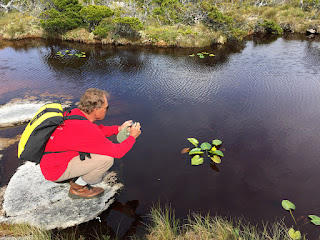 |
| Photo op, Pruth Bay, Hakai |
Boaters are welcome to hike trails to
nine nearby beaches through the woods on boardwalks over to West
Beach, a wide white sandy beach open to the Pacific. It was a much
needed stretch so we continued along to a hilltop look-out with
outstanding views of the ocean.
 |
| Boardwalk trail up to Lookout Mountain, Pruth Bay, Hakai |
There were nine other boats in that
splendid bay, lined up in rows along each side of the bay, leaving a
wide center stage for seaplane landings.
June 14 – Pruth
Cove to Brydon Anchorage
A
full-on steady rain greeted us on waking in Pruth Cove. While gazing
out from under the dodger, Gregg spotted a humpback whale swimming
through the anchorage just off our port side! It surfaced twice
before disappearing.
 |
| Humpback in the anchorage, Pruth Bay, Hakai |
It was still pouring and already past our 0930
planned departure time. Could not decide,
shall we stay or
shall we leave? By 1100 the hard
rain turned to drizzle so we pulled the dinghy up on deck and took
off. Almost immediately, it became inexplicably pleasant out on the
water! We motored out of Kwakshua Channel into Hakai Passage, passing Hakai Lodge, a destination for Seattle seaplane charters, then into Kildidt Sound past the Kittyhawk Island group, navigating through the charted rocks and now under sail into Brydon Channel to Brydon Anchorage where there are three cove choices.
 |
| Hakai Lodge |
We checked out each
one, anchoring in 30'. This place has solitude with a capital S! Except for the thousands of butterfly jellies which became the
entertainment, the views were not interesting.
 |
| Thousands of jellies |
Then as that activity got old,
Gregg cast a fishing line and within minutes caught a small bright
rockfish. He was unable to disengage the hook so we kept it for
dinner. The disappointing truth is that we fished all through Hakai
Passage which is noted for 40 to 50 lb. salmon and we didn't catch a
thing!
 |
| Giant rockfish catch |
June 15, 16 –
Brydon Anchorage to Shearwater Marina, Bella Bella
Today's
destination: Shearwater and Bella Bella. After leaving Brydon
Anchorage we motored into Queen Sound. The wind had not been
cooperating for sailing much lately. We were sure we'd have a good
run in the upcoming Queen or Cultus Sounds but no such luck. While in
Cultus we spotted two otters, one right in front of us in the center
of the channel chomping on a fish, unfazed by our passing.
 |
| Our first sea otter sighting of the trip |
Next came
Lama Passage and then Shearwater Marina. There were lots of boats
already there including the group of cruisers from Gibson's. We
pulled into the last space along the outer end of the T-dock with a
good view of the harbor towards Old Bella Bella. It was late in the
day but we wanted to see Bella Bella, another place name of intrigue.
We took the 10-minute water taxi across the bay to find the four
totems the taxi driver had told us about, returning about an hour
later...not much else there.
 |
| School totem pole, Bella Bella |
On the second day it rained all day
long, and on into the following day. We were desperate for a walk so
began the 1-1/2 miles on the muddy road to the coast guard station at
Old Bella Bella but the puddles were too deep for our shoes. We opted
for dinner out with pub pizza where boaters from four different
tables engaged in lively talk about past and upcoming routes. More cold rain!
 |
| Shearwater Marina |
June 17 –
Shearwater to Quigley Creek Cove
Left the dock 0630
heading north then west into Seaforth Channel. We had a little wind
so we put up the jib for an hour of gentle sailing.
 |
| Sailing for another hour or so, and another sailboat in sight! |
We navigated
through the narrow passage ahead, moving along to Cod Bank, then
across Milbanke Sound to the west side of Price Island, north through
Laredo Sound into Laredo Inlet to Quigley Creek Cove. It had been
calm and grey most of the day but as we made our way through Milbanke
Sound the sky brightened up a little. Unfortunately we kept moving
towards the thick, darker clouds. But as we made our way into Laredo
Inlet and Quigley Creek Cove, incredible! Sun, blue sky, and warmth
for a gorgeous evening. There were very scenic rocky ledges along the
shoreline and trees with rounded mountain views. Many eagles! Went to
sleep without a cloud in the sky.
 |
| Verrrry calm waters in Quigley Creek Cove. |
June 18 – Quigley
Creek Cove to Bent Harbor
Leaving Laredo
Channel we picked up a good NW wind as we sailed SW towards the
southwest tip of Aristazabal Island. We were heading for the outside
coast along Hecate Strait where wild but protected anchorages dot the
coastline. The wind was superb, providing much sought after sail time
in full sun! Enroute to our anchorage in Weeteeam Bay, Bent Harbor,
the wildlife sightings picked up dramatically with a couple of
humpback whales, dolphins and another sea otter! Bent Harbor's scenic
landscape is made up of low lying rocky areas that provide distant
views directly into Hecate Strait to the west. It is otherwise
protected by trees with another cutaway view to the south so it
offers both protection and openness beyond the anchorage. Awesome
day!
 |
| Sailing with both sails up! |
June 19 – Bent
Harbor to Tate Cove, Borrowman Bay
Onward
north. Imagine our surprise at motoring through the potentially
worrisome Hecate Strait with not enough wind to sail! We motored
along the west coast of Aristazabal Island to Borrowman Bay at the
northwest end and caught sight of a humpy show to our delight. There
were several bright green boats in the distance also watching the
whale. On closer view we could see they were from North King Lodge
which we passed on the way into Tate Cove.
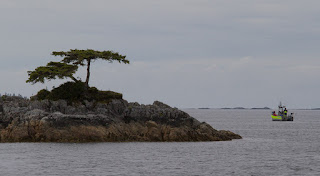 |
| Entrance to Tate Cove, with North King Lodge charter boat |
We immediately clicked
with this anchorage. It was full of eagles, grebes, and has an
interesting shoreline with places to go. After not being able to get
off
True North for
three days we quickly launched the formidable
True Dink
to check out the surrounding places. We'd be able to put out the crab
pot here! We walked the shoreline to see flotsam and jetsam
creatively decorating a beach, then made a stop at the North King
Lodge to find a friendly staffer who talked fishing with us and
showed us around the docks with its heli pad for guest arrivals. They
have twenty fish boats out on the water and run the lodge
continuously with two groups each week all season long. The
well-maintained lodge is on floats and is moved to Prince Rupert
during the winter months. Back at the boat, we deployed the crab trap in about 45'. We checked it with high hopes later in
the evening but found nothing. Our bait, suggested by a clerk in Port
McNeill, was a bit unusual: a sponge soaked in Bait Fuel! There was
another payoff, though: the sunset looking directly west over Hecate
Strait was spectacular with clear skies overhead.
 |
| Surreal sunset in Tate Cove |
June 20-21 –
Weeteeam Bay to McMicking Inlet
It was
hard to leave Tate Cove because it offered so much of interest.
Nevertheless, we did leave because the forecast indicated very strong
wind and rain on the 21st
which, if we stayed, would mean two additional nights and too many
for the pace we set to get ourselves further north. It hasn't felt
hectic to keep moving on; rather, purposeful, moving towards our goal
of being in a place where we can safely wait for a good weather
crossing of Hecate Strait and still arrive in Haida Gwaii in time to
keep a few reservations we made. Those are the plans, in sand...
This was our best
sailing yet with a crystalline day and wind any sailor could happily
embrace. The freedom of traveling by wind power still impresses! We
had rounded the north end of Aristazabal Island through Caamano Sound
under full sails to enter into Estevan Sound earlier than expected
and then navigated the charted rocky McMicking Inlet. Pender Mountain
to the east provides a dramatic granite backdrop to the anchorage.
 |
| Pender Mountain with Sea Drifter in the distance, McMicking Inlet |
We
had seen only one other recreational boat all day but here in the
inlet we passed an anchored yacht on the way inside. They motored
over in their fish boat to say hello, came aboard, and we met Doug
and Jan on
Sea Drifter from Olympia, Washington. They stopped by
again a little later to bring us two huge Dungeness crabs. We had
just finished dinner so we gave the crabs an overnight home in our
crab trap, hung off the stern. The following day proved the weather
forecast to be correct: a strong southerly wind throughout the day
with gusts in the mid-30s and constant, cold rain. The wind howled
until mid-afternoon. We kept a vigilant watch on the shoreline and
ear to the anchor alarm as we swung around. Meanwhile, to pass the
time indoors we read and baked dill bread to accompany the evening
crab dinner. And that is how we spent Summer Solstice, 2016!
 |
| Cleaning the crabs graciously provided by Sea Drifter |
June 22-23 –
McMicking Inlet to Patterson Inlet, Princess Diana Cove
Back to sun the next afternoon brought a show of two pods of Orcas and humpbacks on
the way to Princess Diana Cove at the end of Patterson Inlet.
 |
| Orca whales |
Happy
to be in a cove with landfall opportunities, we dinghied around the
cove, walked the rocky shoreline.
 |
| Tiny crab on barnacles |
On the way back, we stopped to say hello to
Commodore II with John
and Randy aboard. They told us the neighboring boat,
Segue
II had been in Haida Gwaii so we
later found them and spent a couple of hours visiting with David and
Kaye, an interesting couple with many years of boating experiences
throughout the South Pacific, Europe and Scandinavian countries in
particular, first sailing and now in a Nordhavn 47.
 |
| Princess Diana Cove, Patterson Inlet |
From
Patterson Inlet we motored about 3-1/2 hours to Colby Bay, very
pretty and with no other boats present. We dinghied to shore to check
out the old growth cedars. They weren't immediately visible but we
made our way through the mucky mud, still not seeing the cedars. The
woods, mysterious by nature, drew us in about 50' from the beach
where we did see several awesomely large cedars.
Next up, an easy
day motoring to the Spicer Islands. This is a good protected
anchorage to wait for a weather window for crossing Hecate Strait
only we arrived a few days earlier than necessary. We anchored just
off Spicer inside the second passage with a slim view beyond the
anchorage to Hecate Strait. It was again cold and grey and we were
feeling quite isolated from the world. We could either wait there in
the expected drizzle for three days until suitable weather for
crossing Hecate Strait or go someplace else. We chose the latter
almost as soon as the thought took shape and bolted 35 nm north to
Prince Rupert the following morning. We were ready for civilization
and found it!
June 26-27 –
Prince Rupert
Sunshine brings
optimism and with it smiling people! The beautiful new Cow Bay Marina
with helpful and friendly marina staff, wifi, clean showers and
laundry confirmed that it was a good decision to make the detour to Prince Rupert.
 |
| Prince Rupert marinas |
The very first thing we did was to get off the boat and walk. We were
both a little wobbly getting our land legs back but walked around
town and through residential streets to see colorful, lovely old
homes overlooking the bay, visiting with a few locals who were
outside in their front yards. There were also several boats we had
met at anchorages along the way with which we visited over our day and a half break.
 |
| The benefits of civilization |
It became a mini vacation from our vacation being in this
pretty port town with several good restaurants, IPAs, a couple of
good museums, and streets to roam.
 |
| One of many fabulous displays, Museum of North British Columbia |
 |
| 1925 REO Speedwagon fire engine and the fellow who restored it, Fire Museum |
June 28 – Prince
Rupert to Spicer Islands
We were reluctant
to leave the mini-paradise of Prince Rupert but we were facing a slim
weather window over the next few days for crossing Hecate Strait so
back to the Spicer Islands we went with plans to cross on the
following day, forecast to be a good weather day. We did and it was! But we'll describe
that next time!








